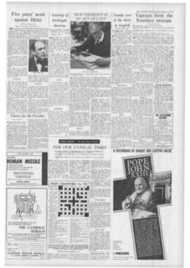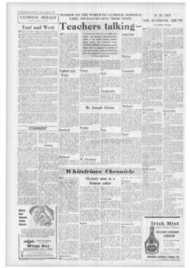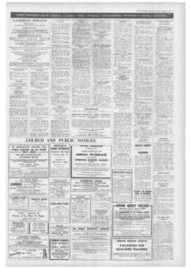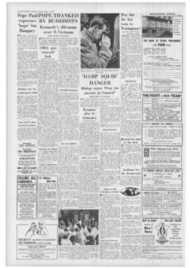Page 4, 23rd August 1963
Page 4

Report an error
Noticed an error on this page?If you've noticed an error in this article please click here to report it.
Tags
Share
Related articles
Betting On The Bishop
Journalist's Eye On Vatican Ii
Letter From Rome
111 7- Hitetrrittrs Chronicle T Here Is Some...
11th Itefriars Chronicle
Whitetriars
Mystery man in a Roman collar
HO is Xavier Rynne? This is a question many people will be asking when Letters from Vatican City is published next week. The anonymous author of this book, which claims to be an inside account of the first session of the Second Vatican Council, gives, in his preface. a list of the people he is not. They include Jack Kerouac,
Wilfrid Shced, "an English Dominican" and "a Roman student who failed his exams" (presumably, therefore, having a grudge against the Roman
educational system). All these guesses, sonic perhaps, more
inspired than others, have been made in various conversations and periodicals.
The latest rumour, among the Roman cognoscenti, is that the mysterious Rynne is an American Redernptorist priest, Fr. Francis Xavier Murphy, who has recently been appointed one of the periti, or experts, for the second session of the Council.
Much of the material in Letters from Vatican City. which runs. as a book, to nearly 300 pages, appeared originally in the New Yorker. The book has already enjoyed a phenomenal sale in America, and Messrs. Faber, who have photographed the American edition for publication in this country, told me this week that they are standing by to rush off further printings if, as they hope, demand soars. .
Xavier Rynne seems certain of a place beside that other anonymous religious commentator. the celebrated author of the preface to Crockfords, Last year. a number of newspapers claimed that they had discovered the author of the preface in Dr. Vigo Dement, a Canon of Christ Church. Oxford. but neither confirmation nor denial has finally settled the issue.
Neighbourliness WHY do so many Catholics from abroad who come to this country lapse? Perhaps part of the answer lies in a letter sent to Fr. Philip Wroe of SS. Simon and Jude, Streatham Hill, S.W.2.. by a 26-year-old Nigerian student.
The writer was born and brought up in the Catholic faith. In his own words. "The Cathoiie faith had always cherished, particularly that part which advocates the love of our neighbours as ourselves. You cannot imagine how disappointed I was. after attending several churches in this country, and findinz that the Spirit of brotherhood in Christ dots not exist among the Catholics over here.
"After very serious thought. I decided in the end that I will never have anything more to do with the Catholic Church. I had even thought of changing my denomination when I get back to Africa. but for my wife, who is not a Catholic, but who did not hesitate to follow my religion when we married in this country.
Restored
"Why have I changed my mind again? This is rather interesting. One Sunday morning, I found myself alone in the house, so I went out for a walk. On getting near your church, I heard the congregation singing the Credo. Without waiting to think. I found myself in the Church. On stepping through the door, a gentleman came straight to me and conducted me to a seat.
"This sense of friendliness, which I had never experienced in all the churches I have attended, gave me a chance to reconsider my rather over-generalized opinion of the Catholics here. After the service, I was given an even bigger surprise. A lady and gentleman came and spoke to ine, asking which part of globe I came from. After I left them, I found that my lost faith in the Catholic Church had been restored for good.
"In conclusion, I would like to convey my sincere thanks to your parishioners. They can, in fact, realize what a world of good they have done if they stop to think what influence this would have carried if I had gone back to my native land with the sort of impression I had before coming to your parish."
For old people ANOTHER of the highly successful courses for those interested in old people's welfare is to be held in October, Miss Stevens, of the National Old People's Welfare Committee tells me.
A recent course on the same lines was the first to be attended by nuns. Two of them — one from Malta and a Carmelite nun from Kent attended the full 14-week course, Nuns have attended the five-day "refresher courses" before, but this is the first time that any attended the long-term one.
It certainly seems to he a thorough training, For the first three weeks, trainees live and work in an old people's home. Thereafter they spend four weeks in London going to lectures, meetings and discussions, followed by four weeks in the geriatric unit of a large hospital and another week in an old people's home.
"For the right sort of people, prospects are extremely good", Miss Stevens told mc. I gather that women between 25 and 50, particularly those with nursing experience. are particularly in demand. There are also openings for married couples to manage homes as a husband-and-wile team.
Cost of the course is £65, but Miss Stevens assures me that most if not all of this can be recouped from local educational authorities. Readers who are interested (and I hope there are many of you) should write to her direct at the N.O.P.W.C., 26 Bedford Square, W.C.I., fairly soon. as I understand that there are usually a considerable number of applications Stella Mans FR BFRNARD BASSET, who w ill be no stranger to our readers, has two contributions in the current issue of Stella Maris, which is also the magazine's Golden Jubilee Number.
In fact, the history of Stella Maris can be dated back to 1901. when it was issued as a "Seaman's Supplement" in the Messenger of the Sacred Heart, Twelve years later, however, it began an independent life of its own as a monthly magazine for the Catholic home. under the editorship of Fr. Edmund Lester, S.J.
One of Er. Lester's major concerns was the saving of late vocations, and the magazine is now, of course, run by Fr. Clement Tiger S.J. from Campion House. Osterley, the Jesuit house for late vocations.
During the war, Stella Maris was enlisted as the official Catholic magazine for the forces. since, owing to the paper shortage, there was no possibility of starting a separate magazine. With the war over. Stella Maris settled back into civilian life. I wish it many more happy anniversaries.
Behind the P.M.
WHO are the men behind Mr. Macmillan? Last Sunday's colour supplement to the Sunday Times showed us their faces. Among them were his secretaries. press officers and advisors on home and foreign affairs.
But how many people. I wonder, noticed the man behind the men behind Mr. Macmillan? There. tucked away on the corner of a table in the Prime Minister's office, was a postcard-size colour portrait of Pope John XXIII. Framed in gold, it showed the smiling pontiff, three-quarter faced to the camera.
The picture was given to Mr. Macmillan by Pope John himself during an audience in 1961. Ever since, I am told, it has had a place of honour in the Prime Minister's offices. At 'present, during the temporary absence from Number 10, it is displayed in the drawing room of Admiralty House.
blog comments powered by Disqus









